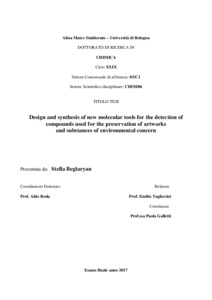Beglaryan, Stella
(2017)
Design and Synthesis of New Molecular Tools for the Detection of Compounds Used for the Preservation of Artworks and Substances of Enviromental Concern, [Dissertation thesis], Alma Mater Studiorum Università di Bologna.
Dottorato di ricerca in
Chimica, 29 Ciclo. DOI 10.6092/unibo/amsdottorato/7925.
Documenti full-text disponibili:
![[img]](http://amsdottorato.unibo.it/7925/1.hassmallThumbnailVersion/Beglaryan_Stella_tesi.pdf)  Anteprima |
|
Documento PDF (English)
- Richiede un lettore di PDF come Xpdf o Adobe Acrobat Reader
Disponibile con Licenza: Salvo eventuali più ampie autorizzazioni dell'autore, la tesi può essere liberamente consultata e può essere effettuato il salvataggio e la stampa di una copia per fini strettamente personali di studio, di ricerca e di insegnamento, con espresso divieto di qualunque utilizzo direttamente o indirettamente commerciale. Ogni altro diritto sul materiale è riservato.
Download (15MB)
| Anteprima
|
Abstract
Polydiacetylenes (PDAs) comprise a class of chromatic polymers which have attracted significant interest over the past 40 years as a promising platform for chemo- and bio-sensing. Specifically, the unique colorimetric and fluorescent transformations of PDA, induced by varied external stimuli, are core properties of these polymers, and have been widely exploited for diverse applications.
This thesis is mainly focused on a design and syntheses of new PDAs, based on 10,12-tricosadynoic acid (TRCDA or TR) derivatives and their practical application in various fields. A pool of TR derivatives were sinthesized in order to examine both the distinct molecular interactions with the compounds tested, as well as modulate the overall structural organization and corresponding colorimetric properties of the sensor films. In particular, the diacetylene monomers examined displayed carboxylic acid (e.g., the commercial product TRCDA), fluorine containing headgroups with different fluorine chain lengths designed to enhance non polar interaction, phenyl boronic acid moiety to establish polar/ionic interactions and eventually form boronic esters with diols-containing materials, ammonium residue aimed to promote ionic interactions with negative compounds, and aminoacid ester derivatives for attaining protein-like hydrogen bonding with polar targets. Photophysical properties and sensing applications of the new PDAs were investigated. Distinct color and fluorescence transitions were induced by various analytes - binding materials of paintings, volatile organic compounds (VOCs), commercially available organophosphate pesticides(OPs). Chromatic transformations were correlated to the analyte structures and properties. Overall, this study presents a new array of TR derivatives which were successfully employed in the colorimetric and/or fluorescent detection of organic compounds present in binding materials of paintings, VOCs and organophosphate pesticides. One of the chapter describes research activity performed at the Heidelberg University, during which new 2,3-dicyano-substituted azaacene derivatives containing 3 to 6 annelated benzene rings were synthesized and characterized.
Abstract
Polydiacetylenes (PDAs) comprise a class of chromatic polymers which have attracted significant interest over the past 40 years as a promising platform for chemo- and bio-sensing. Specifically, the unique colorimetric and fluorescent transformations of PDA, induced by varied external stimuli, are core properties of these polymers, and have been widely exploited for diverse applications.
This thesis is mainly focused on a design and syntheses of new PDAs, based on 10,12-tricosadynoic acid (TRCDA or TR) derivatives and their practical application in various fields. A pool of TR derivatives were sinthesized in order to examine both the distinct molecular interactions with the compounds tested, as well as modulate the overall structural organization and corresponding colorimetric properties of the sensor films. In particular, the diacetylene monomers examined displayed carboxylic acid (e.g., the commercial product TRCDA), fluorine containing headgroups with different fluorine chain lengths designed to enhance non polar interaction, phenyl boronic acid moiety to establish polar/ionic interactions and eventually form boronic esters with diols-containing materials, ammonium residue aimed to promote ionic interactions with negative compounds, and aminoacid ester derivatives for attaining protein-like hydrogen bonding with polar targets. Photophysical properties and sensing applications of the new PDAs were investigated. Distinct color and fluorescence transitions were induced by various analytes - binding materials of paintings, volatile organic compounds (VOCs), commercially available organophosphate pesticides(OPs). Chromatic transformations were correlated to the analyte structures and properties. Overall, this study presents a new array of TR derivatives which were successfully employed in the colorimetric and/or fluorescent detection of organic compounds present in binding materials of paintings, VOCs and organophosphate pesticides. One of the chapter describes research activity performed at the Heidelberg University, during which new 2,3-dicyano-substituted azaacene derivatives containing 3 to 6 annelated benzene rings were synthesized and characterized.
Tipologia del documento
Tesi di dottorato
Autore
Beglaryan, Stella
Supervisore
Co-supervisore
Dottorato di ricerca
Ciclo
29
Coordinatore
Settore disciplinare
Settore concorsuale
Parole chiave
polydiacetylenes, 10,12-tricosadynoic acid derivatives, colorimetric/fluorescent sensors, organic paint binders, aerogel, nanoporous materials, volatile organic compounds, organophosphate pesticides, azaacenes, cyanides, Pd-catalyzed coupling, DFT correlation, n-type semiconductors
URN:NBN
DOI
10.6092/unibo/amsdottorato/7925
Data di discussione
19 Aprile 2017
URI
Altri metadati
Tipologia del documento
Tesi di dottorato
Autore
Beglaryan, Stella
Supervisore
Co-supervisore
Dottorato di ricerca
Ciclo
29
Coordinatore
Settore disciplinare
Settore concorsuale
Parole chiave
polydiacetylenes, 10,12-tricosadynoic acid derivatives, colorimetric/fluorescent sensors, organic paint binders, aerogel, nanoporous materials, volatile organic compounds, organophosphate pesticides, azaacenes, cyanides, Pd-catalyzed coupling, DFT correlation, n-type semiconductors
URN:NBN
DOI
10.6092/unibo/amsdottorato/7925
Data di discussione
19 Aprile 2017
URI
Statistica sui download
Gestione del documento:


 Login
Login
